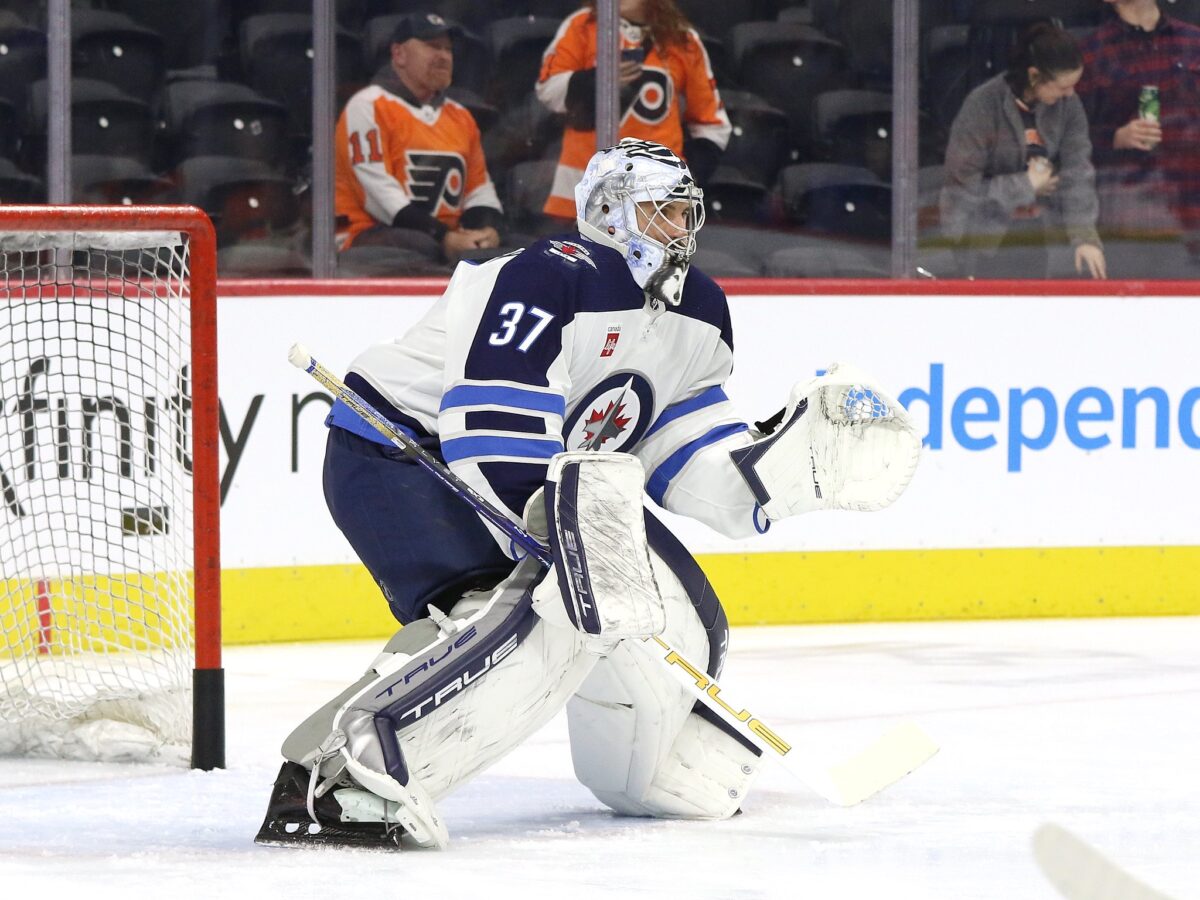Don’t look now, but the start of the 2024 NHL Playoffs (April 20) is just around the corner. The Colorado Avalanche are staring down a first-round match-up with the Winnipeg Jets to kick off the postseason, with the Jets carrying home-ice advantage by virtue of finishing second in the Central Division. The Jets also swept the season series (3-0-0) and outscored the Avalanche 17-4 over those three games, punctuated by a recent 7-0 drubbing on Apr. 13.

The Avalanche have a number of combinations to choose from when it comes to playoff lines, though a recent run of poor results has cast doubt into their potential configuration. Injuries and concerns about scoring balance have also forced the Jets to experiment with their lines, so how both clubs line up for Game 1 is yet to be determined.
The Avalanche will be in tough to advance to the second round based on their performance over the past month and change. Though they’ve won 11 out of 18 games since reshuffling the roster at the 2024 Trade Deadline (March 8), their record over the last 10 games is underwhelming (4-4-2, minus-five goal difference) and is in direct contrast to the Jets’ recent fortunes. Winnipeg won 13 of their final 21 games since the deadline, but are 8-2-0 over their last 10 (plus-16 goal difference) and are riding an eight-game winning streak heading into Game 1.
Related: Revisiting Jets/Avalanche Regular-Season Series Ahead of 2024 Playoff Matchup
The Avalanche’s poor play does not inspire much confidence heading into the playoffs but lost six of the final seven games of the 2021-22 regular season which, if you remember, didn’t have much of an impact on their postseason efforts that spring.
Still, the Jets represent a notable roadblock on the road to the Stanley Cup and the Avalanche must elevate their play if they hope to wash away the bad taste left by their first-round exit in the 2023 Playoffs. Let’s dive into Colorado’s three keys to success in the opening round as they take on one of their main Central Division rivals.
Key #1: Attack the Offensive Zone With and Without the Puck
Head coach Jared Bednar holds the keys when it comes to activating the Avalanche’s game plan, and can count on Nathan MacKinnon (now the franchise record-holder for points in a season), Cale Makar, and Mikko Rantanen among others to drive play.
According to tracking data collected by AllThreeZones (A3Z), the Avalanche rely heavily on action off the rush to create offense. They lead the league in both zone entries leading to a scoring chance and shots off the rush per-60-minutes and force opponents into track meets where they can take advantage of stretched defensive structures. They’re also an above-average team at creating off the cycle, so their versatility makes it more difficult for other teams to contain their stars.
The Jets on the whole have been effective at denying their opponents chances directly off of zone entries (second in chances allowed), but Brendan Dillon, Josh Morrissey, and Neal Pionk (to a lesser extent) represent a few targets the Avalanche can exploit in transition. They usually concede the zone and opt to settle into defensive formation rather than aggressively defend the blue line, so the Avalanche can make them pay for that strategic decision and hope their skill wins out.
Where a crucial battle could occur is in the Jets’ defensive zone between their defensemen and Colorado’s forecheck. The Jets sit within the top 10 of generating defensive zone exits with possession, which contributed to their grading out as a dangerous team moving through the neutral zone and into their opponents’ end. According to A3Z, they were also one of the best teams at completing offensive zone entries that lead to scoring chances either immediately after gaining the zone (rush offense), or after establishing position along the boards.
In contrast to previous seasons, the Avalanche ranked below league-average in both forechecking pressures and offensive zone puck recoveries, according to A3Z. Continuing to be passive could give the Jets a clear path to transition the puck with time and space which is less than ideal when they also have players capable of scoring goals from low-risk areas (Kyle Connor, for example). Having Valeri Nichushkin, Artturi Lehkonen, and Miles Wood fully healthy will help, but the absence of the energetic Logan O’Connor due to season-ending surgery stings more than usual.
Key #2: Get Stable Goaltending From Either Annunen or Georgiev
The widest discrepancy in talent between the two Central-Division heavyweights is visible in the crease where Georgiev is slated to go head-to-head with 30-year-old Connor Hellebuyck, a three-time Vezina Trophy finalist who is likely to collect the award for the second time in his nine-year career.
Hellebuyck finished the regular season with a record of 37-19-4 while starting 60 games (third in the NHL). Among qualified goalies (minimum 10 games played) the American ranked fifth with a .921 save percentage (SV%), eighth with a 2.39 goals-against average (GAA), and saved the most goals above expected (GSAx) in the entire league.
Only Juuse Saros of the Nashville Predators has weathered a heavier workload than Hellebuyck over the past three seasons in terms of starts and shots faced, but the Jets’ talisman continues to be among the very best at his position.

It’s unfair to shovel the blame in any one direction, but it’s hard to look at the recent play of the Avalanche’s goalies — particularly Alexandar Georgiev — and think they’ve a positive influence on their results since the trade deadline. It’s the team’s fatal flaw, and one which could undermine an otherwise dynamic roster when fully healthy.
Georgiev put forth a dark-horse submission for the Vezina last season in his debut campaign with the Avalanche, but his play took a step back in 2023-24. He was once again among the league leaders in games started (second with 62), but saw his SV% (51st), GAA (44th), and GSAx (47th) all fall outside the range for a typical NHL starter. He posted an .882 SV% in 12 games after the trade deadline, and his allowing four goals or more in a game in six of his last eight appearances has created a crisis of confidence in the Avalanche crease.
The inconsistency is a trend that was cited as a reason for concern when Georgiev was acquired from the New York Rangers during the 2022 offseason, and it reared its head this season.
You may also like:
- Colorado Avalanche Won’t Be Contenders This Season
- Colorado Avalanche Lineup Projection for 2024-25
- Avalanche Giving Nikolai Kovalenko a Chance to Prove Himself
- 3 Avalanche Players With the Most to Prove in 2024-25
- Peter “Foppa” Forsberg: A Biography
While Hellebuyck and the Jets clearly hold the upper hand in this department, the wild card for the Avalanche is backup netminder Justus Annunen, who has enjoyed his longest stay in the NHL this season. The 24-year-old outdueled waiver pickup Ivan Prosvetov for the backup job and spelled Georgiev on multiple occasions.
Annunen compiled a record of 8-4-1 in 14 games while posting a .928 SV% (second among goalies with 10 games played), a 2.25 GAA (fifth), and saved nearly 11 goals above expected (25th). He has fewer than 20 games of NHL experience under his belt, but he could be the key to the Avalanche winning the series if Georgiev stumbles out of the gate. Bednar has shied away from openly criticizing his starting netminder, but he’s running out of leash.
Key #3: Capitalize on Power Play Opportunities
The Avalanche have historically been a strong power play team during the MacKinnon era, and that trend continued in 2023-24 with the team ranking fifth in conversion (24.5%) this season.
Bednar can trot out a cavalcade of offensive talent with the man advantage with MacKinnon (second), Rantanen (sixth), and Makar (eighth) all ranking within the top 10 for power play scoring this season. All three of Nichushkin, Jonathan Drouin, and Lehkonen finished with 12 or more power-play points to round out a formidable group up front, though recent injuries to both Drouin and Samuel Girard threaten the effectiveness of their secondary unit.
Despite Hellebuyck performing at a Vezina level, the Jets’ penalty kill struggled all season. Their 77.1% kill-rate ranked 21st in the regular season, and could sink them against a dangerous outfit equipped with the shooting talent to carve open opposing shorthanded units and capitalize on low-percentage opportunities.
Let’s compare the Avalanche’s power play and the Jets’ penalty kill units in terms of the rates at which they generate and concede goals (GF/GA) shots (SF/SA), and expected goals (xGF/xGA).
| Avalanche Powerplay | Statistic (Per-60-Minutes) | Jets Penalty Kill |
| 7th | GF/A | 21st |
| 8th | SF/A | 20th |
| 12th | xGF/A | 22nd |
The Avalanche boast a clear advantage in this particular department, with Hellebuyck unable to paper over the cracks of a penalty kill that has allowed goals, shots, and chance quality at above-average clips this season.
The Avalanche accumulated the third-most minutes on the power play this season while the Jets spent the sixth-lowest amount of time shorthanded, creating tension between effective penalty-drawers and disciplined defenders. MacKinnon (15th), Makar (42nd), Wood (52nd), and Rantanen (71st) all sit in the top 75 of skaters by penalties drawn, giving the Avalanche several players with an underrated skill. Which of the polar opposites prevails could tilt the ice in an otherwise tight series.
Despite their below-average penalty kill results compared to the rest of the league, the Jets can point to their play in the season series as a reason for confidence. They held the Avalanche to a single goal in nine opportunities (11.1%) and neutralized an otherwise-dominant force to help earn home-ice advantage.
The influence of special-teams play cannot be understated, especially not in the playoffs where a single goal or kill can swing the momentum in a small sample of games. If the Avalanche’s stars successfully attack a vulnerable penalty kill, this series could be an unexpectedly short one.
Avalanche Stumbling at Worst Time of the Season
Even if the Avalanche managed to overcome a poor end to the regular season during their Cup-winning campaign, it’s less than ideal that they’ve looked the worst they have all season over the past month with the division and conference titles on the line. They will have to hope that the version of the Avalanche thatt emerges in the playoffs is more in line with the one which throttled the Edmonton Oilers, rather than the one which was outscored 14-4 in a pair of games against the Dallas Stars and Jets over the past two weeks.
The Avalanche’s roster has Stanley-Cup pedigree, so it would not be surprising to see them flip a switch once the stakes are higher given that they understand what it takes to win four rounds in succession. If Colorado’s stars can draw from their well of experience against a Jets squad whose key players haven’t accomplished much in the postseason since a run to the Western Conference Final in 2018, they could win what’s likely to be a very tight series.
If not, the front office may have their hands full this offseason while trying to reshape the roster around their vaunted core, and some difficult conversations may need to be had ahead of 2024-25. The legacies of the Avalanche’s stars were secured with the 2022 championship, but they can further entrench themselves in hockey lore with another title – no pressure.
Data courtesy of AllThreeZones, Evolving Hockey, Natural Stat Trick, and the NHL.
